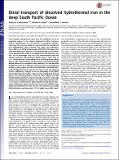| dc.contributor.author | Jenkins, William J. | |
| dc.contributor.author | Fitzsimmons, Jessica Nicole | |
| dc.contributor.author | Boyle, Edward A | |
| dc.date.accessioned | 2015-06-02T13:46:40Z | |
| dc.date.available | 2015-06-02T13:46:40Z | |
| dc.date.issued | 2014-11 | |
| dc.date.submitted | 2014-04 | |
| dc.identifier.issn | 0027-8424 | |
| dc.identifier.issn | 1091-6490 | |
| dc.identifier.uri | http://hdl.handle.net/1721.1/97145 | |
| dc.description.abstract | Until recently, hydrothermal vents were not considered to be an important source to the marine dissolved Fe (dFe) inventory because hydrothermal Fe was believed to precipitate quantitatively near the vent site. Based on recent abyssal dFe enrichments near hydrothermal vents, however, the leaky vent hypothesis [Toner BM, et al. (2012) Oceanography 25(1):209–212] argues that some hydrothermal Fe persists in the dissolved phase and contributes a significant flux of dFe to the global ocean. We show here the first, to our knowledge, dFe (<0.4 µm) measurements from the abyssal southeast and southwest Pacific Ocean, where dFe of 1.0–1.5 nmol/kg near 2,000 m depth (0.4–0.9 nmol/kg above typical deep-sea dFe concentrations) was determined to be hydrothermally derived based on its correlation with primordial [superscript 3]He and dissolved Mn (dFe:[superscript 3]He of 0.9–2.7 × 10[superscript 6]). Given the known sites of hydrothermal venting in these regions, this dFe must have been transported thousands of kilometers away from its vent site to reach our sampling stations. Additionally, changes in the size partitioning of the hydrothermal dFe between soluble (<0.02 µm) and colloidal (0.02–0.4 µm) phases with increasing distance from the vents indicate that dFe transformations continue to occur far from the vent source. This study confirms that although the southern East Pacific Rise only leaks 0.02–1% of total Fe vented into the abyssal Pacific, this dFe persists thousands of kilometers away from the vent source with sufficient magnitude that hydrothermal vents can have far-field effects on global dFe distributions and inventories (≥3% of global aerosol dFe input). | en_US |
| dc.description.sponsorship | National Science Foundation (U.S.). Graduate Research Fellowship (Award 0645960) | en_US |
| dc.description.sponsorship | Center for Microbial Oceanography: Research and Education (NSF-OIA Award EF-0424599) | en_US |
| dc.description.sponsorship | Gordon and Betty Moore Foundation | en_US |
| dc.language.iso | en_US | |
| dc.publisher | National Academy of Sciences (U.S.) | en_US |
| dc.relation.isversionof | http://dx.doi.org/10.1073/pnas.1418778111 | en_US |
| dc.rights | Article is made available in accordance with the publisher's policy and may be subject to US copyright law. Please refer to the publisher's site for terms of use. | en_US |
| dc.source | National Academy of Sciences (U.S.) | en_US |
| dc.title | Distal transport of dissolved hydrothermal iron in the deep South Pacific Ocean | en_US |
| dc.type | Article | en_US |
| dc.identifier.citation | Fitzsimmons, Jessica N., Edward A. Boyle, and William J. Jenkins. “Distal Transport of Dissolved Hydrothermal Iron in the Deep South Pacific Ocean.” Proceedings of the National Academy of Sciences 111, no. 47 (October 27, 2014): 16654–16661. | en_US |
| dc.contributor.department | Massachusetts Institute of Technology. Department of Earth, Atmospheric, and Planetary Sciences | en_US |
| dc.contributor.mitauthor | Fitzsimmons, Jessica N. | en_US |
| dc.contributor.mitauthor | Boyle, Edward A. | en_US |
| dc.relation.journal | Proceedings of the National Academy of Sciences | en_US |
| dc.eprint.version | Final published version | en_US |
| dc.type.uri | http://purl.org/eprint/type/JournalArticle | en_US |
| eprint.status | http://purl.org/eprint/status/PeerReviewed | en_US |
| dspace.orderedauthors | Fitzsimmons, Jessica N.; Boyle, Edward A.; Jenkins, William J. | en_US |
| dc.identifier.orcid | https://orcid.org/0000-0002-6394-1866 | |
| mit.license | PUBLISHER_POLICY | en_US |
| mit.metadata.status | Complete | |
